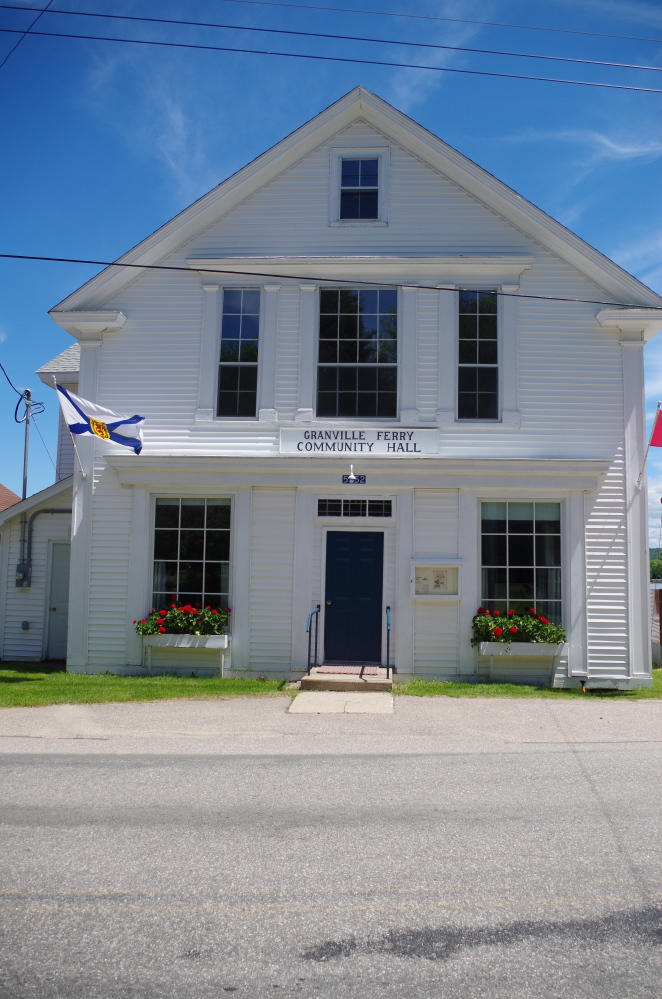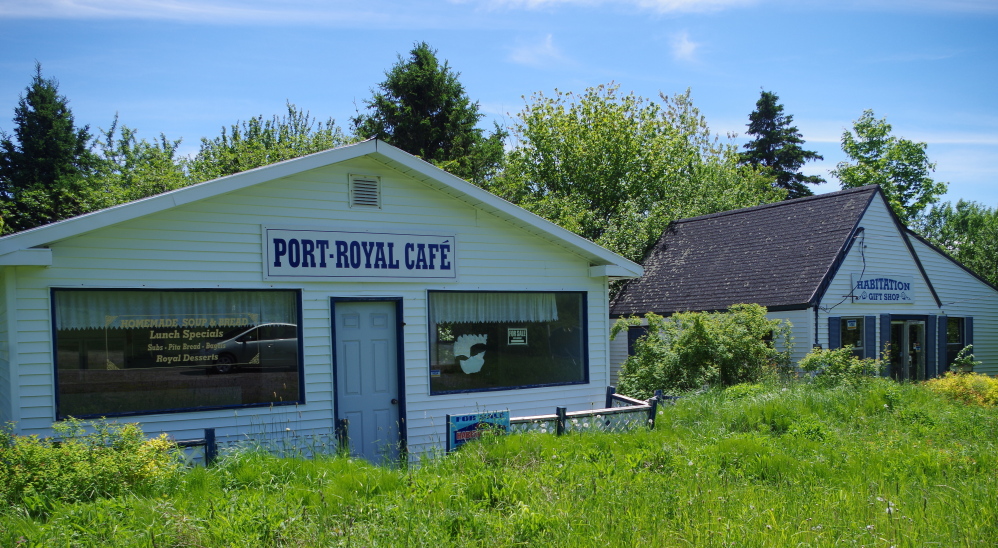GRANVILLE FERRY, Nova Scotia — Drop a Mainer in this village of clapboard-sided, 19th-century houses and he might well guess he was standing in midcoast Maine. There’s a well-maintained community hall, an elementary school, the tall spire of a church, sea captain’s houses and a bed-and-breakfast in a New England-style house built as an inn more than two centuries ago.
But despite being the hub of one of the oldest European settlements in northeastern North America – Samuel Champlain helped found a settlement just down the shore in 1605 – Granville isn’t really a town at all. There’s no town meeting, clerk, hall, budget or selectmen. Like most of the other centuries-old communities hereabouts, it’s just another part of Annapolis County, whose officials provide public services, maintain the roads and catch errant dogs.
Across Nova Scotia, towns are becoming thinner on the ground. A province with about two-thirds the land mass and population of Maine, it now has just 28 independent towns plus the Halifax metro area, compared to 491 in Maine. Bridgetown, 14 miles west of here, gave up its independence in April, merging with the county. Springhill, a historic coal mining town of 2,500, dissolved into Cumberland County in March.
“There was no conflict because residents knew they just couldn’t afford to continue,” Annapolis County head Reginald Ritchie says of Bridgetown, population 960, which faced a multimillion-dollar bill to upgrade an aging water system. “That was a major cost they just couldn’t bear.”
In an effort to reduce costs and improve services, Nova Scotia and New Brunswick have been consolidating municipal government functions for decades, creating a substantial record of experience that Mainers might draw on to inform potential mergers. Lewiston and Auburn are studying becoming one city, and the governor highlighted municipal reform in his most recent inaugural address. The experience of these provinces – which have similar demographic, cultural, economic and geographic characteristics as Maine – is a cautionary tale, as promised savings often failed to materialize, especially when larger towns and cities were involved.
For decades, Maine’s political leaders have pointed to the need to loosen the state’s “home rule” system of strong local governments, wherein municipalities of a few hundred or thousand inhabitants each act as a tiny republic unto themselves, theoretically controlling everything from schools and land use planning to road plowing, fire station maintenance and the holding of elections. Governors – independent, Democratic and Republican – have argued that the state can’t afford such a fractured, redundant system of government, with nearly 500 separate and often defiantly independent cities and towns.
Gov. Paul LePage put the issue back on the agenda in his Jan. 7 inaugural address, saying municipal spending was “unacceptable.”
“Local control is great, but no one wants to pay for it,” LePage said. “We will never be competitive until we learn to share services by working together.”
WHY SAVINGS AREN’T A SURE THING
In Nova Scotia and New Brunswick, economically moribund provinces that have been losing rural population for decades, provincial authorities forced many municipalities to merge – or “amalgamate,” in Canadian parlance – in the 1990s. Halifax effectively annexed sister cities Bedford and Dartmouth to form a metropolitan area of 400,000, half of Nova Scotia’s population and six times the size of Maine’s largest city, Portland. In New Brunswick, the eastern towns of Chatham and Newcastle – facing each other across a river – were melded with nine rural hamlets to forge the new city of Miramichi, while the border town of Edmundston, across the river from Madawaska, absorbed 11 rural neighbors. (Schools weren’t affected by the changes, as education is a provincial function in Canada.)
As in Maine, proponents of these and other 1990s mergers argued amalgamation would save money by eliminating redundant administrators, reducing the number of elected officials, and achieving economies of scale in both the purchase of infrastructure and the delivery of police, fire, trash collection and other services. Those who’ve studied or participated in the changes say it didn’t always turn out that way.
“Most of the arguments about efficiency don’t really pan out,” says James McDavid of the School of Public Administration at the University of Victoria, British Columbia, who studies municipal mergers. “You might get some efficiencies if you talk about amalgamating infrastructure like roads, sewer and water, but the argument falls off the rails when you’re dealing with functions involving human beings interacting with residents.” That’s because wages and benefits usually rise after a merger, especially when unionized police, fire or public works departments are involved.
McDavid studied the effects on the cost and quality of police services in metro Halifax three years after its 1996 annexation of its immediate neighbors. His conclusions: “higher costs (in real-dollar terms), lower numbers of sworn officers, lower service levels, no real change in crime rates, and higher workloads for sworn officers.”
The reason, McDavid says, is a substantial increase in salaries as officers from suburban Bedford and Dartmouth “leveled up” to the wages and benefits of their Halifax counterparts. To balance the budget, services were cut back, such as vacation or nighttime checks on unoccupied homes or businesses or timely responses to burglary calls.
Andrew Scanton, professor of political science at the University of Western Ontario, came to similar conclusions in his work. “I don’t think anyone has found any evidence that the Halifax amalgamation saved money,” says Scanton, who found it hard to establish firm numerical conclusions because the new city also increased many services, making comparisons to the former city budgets difficult.
POLITICALLY LOADED ISSUE
Harry Kitchen, an economist at Trent University in Ontario, says saving money isn’t the best argument for consolidating municipalities – rather, sharing the burden of providing services is, especially where a rural or unincorporated area sits alongside a town or service center.
“In the pre-amalgamation days, the rural people would come into the town and use the streets and sidewalks and parks, but they weren’t paying for any of the services,” Kitchen says. “After amalgamation you get a better redistribution of the tax base, and that’s really worth looking at.”
Mergers involving smaller communities have seen clearer successes, particularly when initiated by the communities themselves. In 1996, the old seafaring town of Liverpool, Nova Scotia (population 2,500), voluntarily merged with Queens County, creating a municipal unit of 11,000. John Leefe, the county mayor at the time, says the county saw significant reductions in salary expenditures as the number of elected officials and police commissioners was halved.
“You would be hard-pressed in this area to find people who want to go back to what we had before,” Leefe says.
Nova Scotia’s counties have considerable power, giving people in unincorporated areas political clout. In New Brunswick, however, the system resembles that in Maine, with large numbers of towns (101 in a province of 750,000) and vast unorganized territories administered directly from the capital. As in Maine, experts have called for a vast overhaul, especially given stagnant population growth and a moribund economy.
But a series of forced mergers in the 1990s – including Miramichi, the Saint John suburbs, and the Edmunston area across the border from Madawaksa – made top-down amalgamation politically toxic. A 2008 report prepared for the government recommended all existing administrative units – the 101 towns and 267 unorganized districts – be erased and replaced with just 53 towns, themselves encouraged to cooperate across 12 regions. It was instantly shelved and hasn’t seen the light of day since.
“As soon as I saw that report I just knew we would have a fight on our hands,” says Jack Keir, who was energy minister at the time and recommended that New Brunswick Premier Shawn Graham shelve the report. “If the politicians got the guts to force amalgamation, I believe it would probably benefit the whole community, but I don’t know if politicians have the guts to do it anymore.”
WHAT SIZE TOWNS MAKE MERGING WORK?
Mergers became politically unpopular precisely because they were forced from above, argues Hendrik Slegtenhorst, a former town manager of St. Stephen, New Brunswick, which merged with its blue-collar neighbor, Milltown, in 1973. “Community identity is the manifestation of the people who make up that community,” he says. “Once you subsume that into a larger whole that’s not necessarily compatible with it, then you have not so much dilution of identity, but a drowning of it.”
The reduction in the number of elected officials per capita is to be mourned, he says, because it gives each citizen less of a voice. “There are no economies of scale in the democratic process,” he says. “Forced amalgamation is unpopular because it can produce bigger, not necessarily better, government.”
Back in Nova Scotia, David Corkum, past president of the Union of Nova Scotia Municipalities and current mayor of Kentville, says there’s a happy medium between towns too small to be viable and too large to ensure accountability. “I can tell you that once you get over about 20,000 people, you lose control, but also that towns of less than – I hate to say it – 3,500 people probably shouldn’t exist.”
He says his town of 6,000 has saved money by making agreements with neighboring communities to share fire, recreation, sewer, and garbage collection services. “You don’t necessarily have to amalgamate to share your services and find savings,” he notes.
Scanton of the University of Western Ontario says voluntary mergers are most likely to be successful ones, as people on the ground have the best sense of their communities. “There’s no reason to perpetuate old municipalities just because they’ve been there a long time,” he says. “But it’s not accountants or public administration experts like me who are the people who should decide if they should keep their municipality or not.”
Cokrum agrees that’s the ideal, but warns that municipalities that have lost their viability sometimes wait too long to act. “It’s a situation like a gambling addict,” he says. “They’ll be pretty much bankrupt before they agree to go that route.”
Copy the Story Link
Send questions/comments to the editors.




Success. Please wait for the page to reload. If the page does not reload within 5 seconds, please refresh the page.
Enter your email and password to access comments.
Hi, to comment on stories you must . This profile is in addition to your subscription and website login.
Already have a commenting profile? .
Invalid username/password.
Please check your email to confirm and complete your registration.
Only subscribers are eligible to post comments. Please subscribe or login first for digital access. Here’s why.
Use the form below to reset your password. When you've submitted your account email, we will send an email with a reset code.